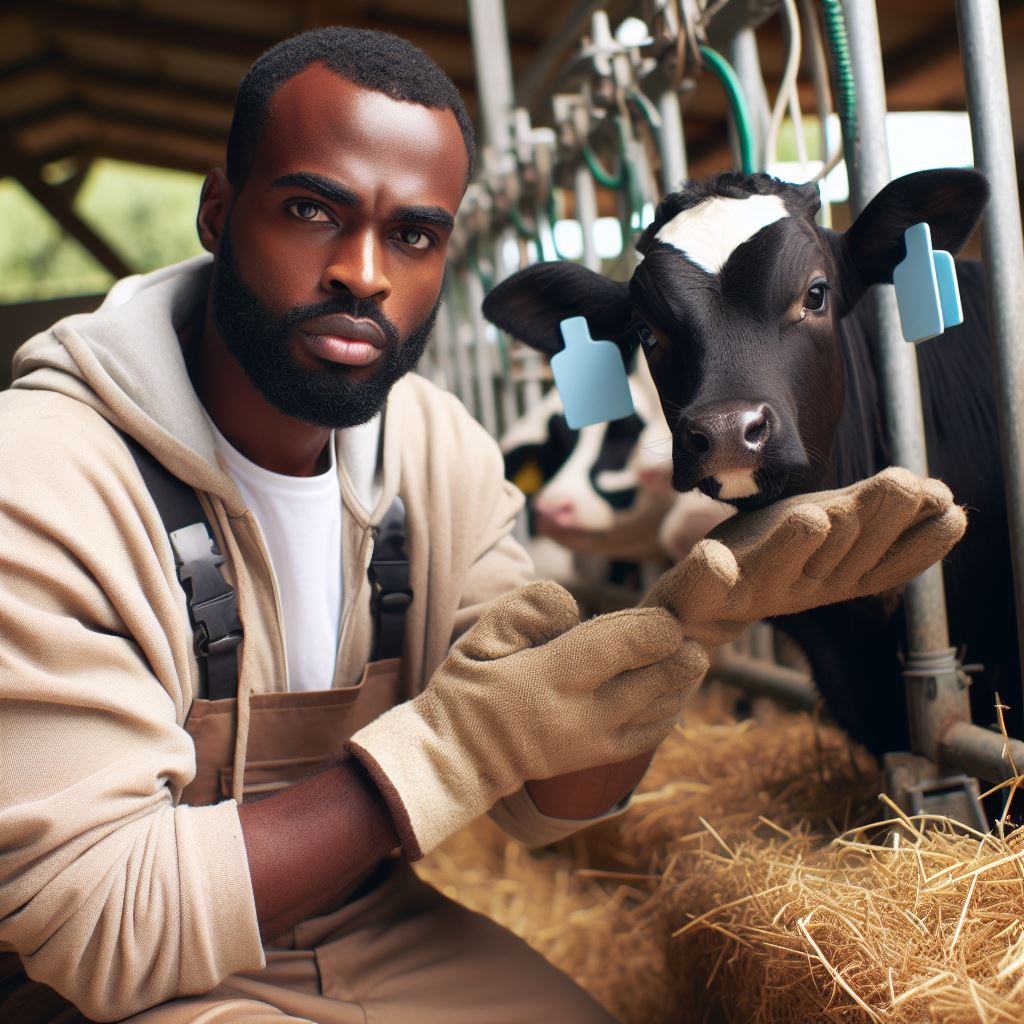Introduction
Animal production courses play a crucial role in Nigeria, contributing to overall agricultural development and economic growth.
These courses focus on breeding, husbandry, and management practices for livestock and poultry, aiming to enhance productivity and food security.
The impact of technology on animal production courses in Nigeria has been significant.
Technological advancements have revolutionized various aspects of these courses, leading to improved efficiency, productivity, and profitability.
Modern tools and techniques are now integrated into the curriculum, offering students hands-on experience and preparing them for the evolving industry.
Importance of animal production courses in Nigeria
Animal production courses are essential for sustainable food production and agricultural development.
They equip students with the knowledge and skills necessary to manage and optimize livestock and poultry production.
These courses contribute to food security, income generation, and the overall growth of the agricultural sector in Nigeria.
Impact of technology on animal production courses
Technology has transformed animal production courses, revolutionizing traditional farming methods.
The use of advanced reproductive technologies, such as artificial insemination and embryo transfer, has significantly improved breeding efficiency and genetic progress.
Precision farming techniques, including remote sensing, drones, and sensors, enable efficient monitoring and management of livestock and poultry production systems.
Moreover, technology-driven data analytics and decision support systems assist farmers in making informed decisions regarding animal nutrition, health management, and overall farm management.
Students now have access to modern laboratory equipment, computer software, and online resources, enhancing their learning experience and practical skills.
In fact, animal production courses in Nigeria play a crucial role in agricultural development, ensuring food security and economic growth.
The integration of technology has transformed these courses, making them more efficient, productive, and aligned with evolving industry practice.
Embracing technology in animal production education is essential to keep pace with the changing needs and demands of the sector.
Read: Nigeria’s Animal Health Research: Breakthroughs & Impact
Traditional methods of teaching animal production courses
In this section, we will explore the traditional methods of teaching animal production courses in Nigeria and delve into the limitations and challenges associated with these methods.
The traditional methods used in teaching animal production courses
- Classroom lectures are the primary traditional method used to teach animal production courses.
- Professors deliver lectures to students, providing theoretical knowledge about animal production practices.
- Students attend classes, take notes, and engage in discussions around the topics covered in lectures.
- Field trips to agricultural farms and zoological parks are also part of the traditional teaching methods.
- During these trips, students have the opportunity to observe and learn about animals in practical settings.
- Guest lectures by industry professionals are occasionally arranged to enrich the learning experience.
These traditional teaching methods have been used for years to impart knowledge in animal production courses. However, they come with their limitations and challenges.
The limitations and challenges associated with traditional teaching methods
- Limited practical exposure restricts students to theoretical knowledge, hindering their comprehensive understanding of animal production.
- Large class sizes make it difficult for professors to provide individual attention to each student.
- Traditional methods often lack interactive and engaging elements, leading to passive learning experiences.
- Keeping up with advancements and innovations in animal production becomes a challenge with static teaching methods.
- The cost and logistics involved in organizing frequent field trips pose constraints on their regular implementation.
- Guest lectures may not always be available, limiting students’ exposure to industry experts.
These limitations and challenges highlight the need for incorporating technology into animal production courses in Nigeria.
In the next section, we will explore how technology is shaping animal production courses in Nigeria, addressing the shortcomings of traditional teaching methods.
Read: Postgraduate Opportunities in Animal Production in Nigeria
Role of technology in animal production courses
The various technologies being used in animal production
Animal production courses in Nigeria have greatly evolved due to the integration of advanced technologies.
These technologies have revolutionized the way animals are bred, fed, and monitored, leading to significant improvements in animal production efficiency and overall output.
The benefits of each technology in improving animal production
Artificial insemination technology
This technology involves the manual injection of semen into the reproductive tract of a female animal, bypassing natural mating. It has several benefits in improving animal production.
Firstly, artificial insemination allows for the mating of superior animals, regardless of geographical constraints.
This means that highly productive breeds can be utilized even if they are not physically present on the farm.
As a result, reproduction rates can be significantly increased, leading to a greater number of offspring with desirable genetic traits.
Secondly, artificial insemination reduces the risk of disease transmission that can occur during natural mating. This helps to maintain the health of the livestock population and prevent potential outbreaks.
Precision feeding technology
Precision feeding involves the use of advanced monitoring and feeding systems to deliver precise amounts of feed to each animal based on their specific nutritional requirements.
By utilizing precision feeding technology, farmers can optimize feed utilization, minimize waste, and ensure that each animal receives the necessary nutrients for maximum growth and productivity.
This not only improves the overall efficiency of animal production but also results in substantial cost savings on feed expenses.
Remote sensing and monitoring technology for animal health
This technology utilizes various sensors, cameras, and monitoring devices to continuously gather data on animal health and behavior.
Early detection of health issues is crucial in animal production, as it allows prompt intervention and treatment, minimizing the impact on animal welfare and productivity.
Remote sensing and monitoring technology enable farmers to identify signs of distress or disease in animals, such as abnormal behavior or vital sign fluctuations, remotely.
This proactive approach to animal health management helps prevent disease outbreaks and improves overall animal well-being.
In essence, the integration of technology in animal production courses in Nigeria has brought about significant advancements.
Technologies such as artificial insemination, precision feeding, and remote sensing and monitoring have transformed the way animals are bred, fed, and monitored.
The benefits derived from these technologies, such as increased reproduction rates, enhanced efficiency, cost savings, and early detection of health issues, have greatly improved animal production in Nigeria.
Read: Emerging Technologies in Animal Health: Nigeria’s Approach
Transform Your Career with Expert Guidance
Get personalized mentorship consulting that’s tailored to your unique path. Our expert advice is actionable and exclusive.
Get StartedIntegration of technology in animal production curriculum
How technology is being integrated into animal production courses in Nigeria
Technology has become an integral part of animal production courses in Nigeria, as educators leverage its potential to enhance learning outcomes.
Instructors are incorporating various tech tools like simulations, virtual reality, and multimedia resources to supplement traditional teaching methods.
These technologies are used to demonstrate complex concepts, stimulate student engagement, and facilitate practical knowledge acquisition.
To illustrate, virtual reality (VR) is revolutionizing animal production education by providing immersive experiences.
Students can now virtually visit farms, observe livestock, and participate in the decision-making process related to animal rearing and breeding.
This realistic approach aids in their understanding of industry practices, challenges, and management strategies.
Additionally, students can interact with virtual animals, further enhancing their practical skills development without the constraints of time and location.
Various software applications are also being used to demonstrate and analyze animal production data, including nutrition and health parameters.
Students can now collect, analyze, and interpret data using specialized software, enabling them to make informed decisions in livestock management.
Such applications offer real-time insights and simulations, fostering critical thinking and problem-solving skills among students.
The importance of including technology-based learning in the curriculum
The inclusion of technology-based learning in the animal production curriculum is crucial for several reasons. Firstly, it enhances student engagement and motivation.
Technology-based tools, such as virtual reality and multimedia resources, make learning captivating and immersive, resulting in increased interest and active participation.
Moreover, technology-based learning provides flexibility and convenience.
By leveraging online platforms, course materials and resources can be accessed anytime and anywhere, enabling students to review and revise at their own pace.
This promotes self-directed learning, allowing students to tailor their educational experience to their individual needs and preferences.
Additionally, technology-based learning equips students with skills required in the modern job market.
Utilizing tech tools prepares them for real-life scenarios they may encounter in the animal production industry, such as data analysis, precision farming, and remote monitoring.
By gaining proficiency in these technologies, students become more employable and adaptable to future advancements.
Lastly, incorporating technology-based learning fosters collaboration and networking among students.
Online forums, discussion boards, and virtual teamwork platforms facilitate knowledge sharing and peer interaction, enabling students to learn from each other’s experiences and perspectives.
This collaborative environment enhances communication skills and builds a sense of community among learners.
The impact of incorporating technology in improving students’ practical skills and knowledge in animal production
The integration of technology in animal production courses has significantly enhanced students’ practical skills and knowledge.
Technology-enabled simulations and virtual experiences allow students to immerse themselves in real-world scenarios, developing practical skills without the limitations of physical access or resources.
For example, through virtual farm visits and interactive simulations, students can practice animal handling, breeding, and nutrition management.
This hands-on approach enables them to gain confidence in their abilities and apply theoretical concepts to practical situations.
Additionally, technology-based platforms provide instant feedback, enabling students to understand their mistakes and make necessary adjustments for improvement.
The use of technology also enhances students’ theoretical knowledge by providing access to a vast array of resources.
Multimedia content, online libraries, and educational websites offer up-to-date information on animal production practices, advancements, and research.
This promotes self-learning and encourages students to stay updated with industry trends and innovations.
Moreover, technology-based learning facilitates effective assessment and evaluation of students’ progress.
Online quizzes, interactive assignments, and virtual lab experiments allow instructors to gauge students’ understanding of concepts and identify areas that require further attention.
This continuous feedback loop ensures that students receive personalized guidance and support, resulting in improved learning outcomes.
Basically, the integration of technology into animal production courses in Nigeria is transforming the academic landscape.
By leveraging technology-based learning tools, instructors are enhancing student engagement, promoting practical skills development, and equipping students with industry-relevant knowledge.
As technology continues to advance, the integration of these tools will play a vital role in preparing future professionals for the challenges and opportunities in animal production.
Read: Career Prospects: Animal Health Tech Graduates in Nigeria

Challenges and Considerations in Adopting Technology in Animal Production Courses
Tackling Potential Challenges and Limitations
In the dynamic landscape of animal production courses in Nigeria, integrating technology encounters hurdles.
Limited internet access, particularly in rural areas, impedes seamless tech adoption. Resistance to change among educators and students poses a significant challenge.
Moreover, the cost associated with acquiring and maintaining technology can be prohibitive for some institutions.
Outdated infrastructure exacerbates compatibility issues, hindering the smooth implementation of digital tools.
The Crucial Role of Training and Support
Recognizing the importance of overcoming these challenges, providing robust training for educators and students becomes paramount.
Adequate support structures must be in place to assist in navigating the technological learning curve. This support extends beyond the initial integration phase, ensuring sustained proficiency.
Educators need to feel confident in utilizing technology as a teaching aid, and students must be equipped with digital literacy skills.
Workshops, online resources, and dedicated support staff contribute to a more tech-savvy learning environment.
Continuous Updating and Upgrading for Technological Relevance
As technology evolves at a rapid pace, the animal production sector must keep pace to remain relevant. An indispensable aspect of this process is the continuous updating and upgrading of technological tools.
This ensures that educational content aligns with the latest advancements in animal husbandry and related fields.
By embracing a proactive approach to technology, institutions can cultivate an environment conducive to innovation.
Regular assessments of the effectiveness of existing tools help identify areas for improvement.
This commitment to staying current not only enriches the learning experience but also prepares students for the tech-driven future of animal production.
Basically, addressing challenges, providing robust training, and embracing technological evolution are integral to shaping the future of animal production courses in Nigeria.
Only through a concerted effort can the transformative power of technology be harnessed for the benefit of educators, students, and the industry at large.
Case studies on successful implementation of technology in animal production courses
Examples of institutions or individuals who have successfully incorporated technology in their animal production courses
- The Federal University of Agriculture, Abeokuta: Introduced online modules and virtual labs for practical training.
- Dr. John Okonkwo: Implemented a mobile app that provides students with interactive quizzes and study materials.
- The University of Ibadan: Utilized drones for monitoring livestock and collecting real-time data for research purposes.
- Dr. Adaobi Ezechi: Integrated video conferencing tools to connect students with industry experts for guest lectures.
Outcomes and benefits achieved through the use of technology in these cases
- Enhanced learning experience: Students can access educational resources anytime and anywhere, increasing their engagement and understanding of the subject matter.
- Improved practical training: Online modules and virtual labs provide hands-on experience in a controlled environment.
- Increased collaboration: Technology facilitates communication and collaboration among students, enabling them to work on group projects effectively.
- Real-time data collection and analysis: The use of drones and other technological tools allows for efficient data gathering and analysis, leading to more accurate research outcomes.
- Industry exposure: Video conferencing tools enable students to interact with industry experts and gain valuable insights into the field of animal production.
- Cost-effectiveness: Incorporating technology reduces the need for physical infrastructure and resources, making education more accessible and affordable.
- Preparation for the digital era: By utilizing technology in animal production courses, institutions and individuals prepare students for the evolving demands of the industry.
- Efficient assessment and feedback: Technology aids in automated assessment, providing timely feedback to students, helping them track their progress.
- Increased job prospects: Students equipped with technological skills have a competitive advantage in the job market.
- Improved animal welfare: Technology enables better monitoring and management of livestock, ensuring their well-being and minimizing health risks.
Furthermore, the cost-effectiveness of technology-based education makes it more accessible to a broader range of students.
This inclusivity ensures that aspiring animal production professionals from all socioeconomic backgrounds can pursue their education and contribute to the industry’s growth.
Essentially, the successful integration of technology in animal production courses has proven to be a game-changer for education in Nigeria.
The examples provided demonstrate the positive outcomes and benefits of embracing technology, which include enhanced learning experiences, improved practical training, increased collaboration, and efficient data collection.
By adopting technological advancements, institutions and individuals not only create better learning opportunities but also prepare students for the future demands of the industry, ultimately contributing to the growth and development of animal production in Nigeria.
Future prospects of technology in animal production courses
Potential future advancements and trends in technology for animal production courses
- Integration of artificial intelligence (AI) in animal production courses to optimize decision-making processes.
- Advancements in precision agriculture, including the use of sensors and drones for monitoring and managing animal health.
- Development of virtual reality (VR) and augmented reality (AR) tools for immersive learning experiences in animal production.
- Emergence of wearable devices for real-time monitoring of animal behavior, health, and productivity.
- Application of big data analytics and machine learning algorithms to improve animal production efficiency and sustainability.
- Growth of blockchain technology for transparency and traceability in animal production supply chains.
- Incorporation of 3D printing technology in creating customized equipment and prosthetics for animal care.
- Utilization of nanotechnology for targeted drug delivery and disease prevention in animals.
- Exploration of gene editing tools like CRISPR-Cas9 for genetic improvement and disease resistance in livestock.
- Implementation of robotic systems for automated feeding, cleaning, and monitoring of animals.
The possible impact of technology on the future of animal production in Nigeria
The future of animal production in Nigeria holds tremendous potential with the incorporation of technology. These advancements are expected to revolutionize the industry in various ways:
- Increased productivity: The adoption of technology can enhance animal health monitoring, leading to early disease detection and prevention. This can result in improved productivity and higher quality products.
- Efficient resource utilization: Precision agriculture tools can optimize resource use, such as feed and water, reducing waste and costs while promoting sustainability.
- Enhanced education and training: The integration of AI, VR, and AR in animal production courses can provide students with realistic and immersive learning experiences, better preparing them for real-world challenges.
- Improved data-driven decision making: Big data analytics coupled with AI algorithms can provide valuable insights into production processes, enabling informed decision making and improved efficiency.
- Transparency and consumer trust: Blockchain technology can ensure traceability and transparency in the animal production supply chain, increasing consumer trust in the industry.
- Job creation and economic growth: The adoption of new technologies in animal production will require skilled professionals, leading to job creation and overall economic growth.
- Addressing sustainability challenges: Nanotechnology and gene editing tools can contribute to disease prevention, reduced environmental impact, and increased resistance to climate change.
- Improved animal welfare: Robotic systems and wearables can monitor animal behavior and health, allowing for early intervention and improved welfare conditions.
- Customized solutions: 3D printing technology can enable the creation of personalized equipment and prosthetics for animals with specific needs or disabilities.
Essentially, the future prospects of technology in animal production courses in Nigeria are promising.
From AI and precision agriculture to VR and nanotechnology, these advancements have the potential to transform and enhance the industry, leading to increased productivity, sustainability, and improved animal welfare.
Conclusion
In Nigeria, animal production courses are undergoing a transformative shift, driven by the relentless integration of technology.
Modernizing education, technology offers students practical insights into livestock management.
Real-time data collection, facilitated by technology, equips students with a dynamic understanding of animal behavior, health, and nutrition.
These courses have evolved beyond traditional textbooks, embracing immersive experiences through virtual simulations.
Precision agriculture, powered by technology, optimizes resource utilization in animal farming.
From automated feeding systems to wearable health monitors, students learn to implement cutting-edge solutions for efficient livestock management.
The significance of these advancements lies in their ability to address challenges faced by the Nigerian animal production industry.
Technology-driven courses empower students to develop sustainable practices, ensuring food security and economic growth.
The impact of technology in shaping animal production courses cannot be overstated.
It bridges the gap between theoretical knowledge and practical application, preparing students for the complexities of modern agriculture.




